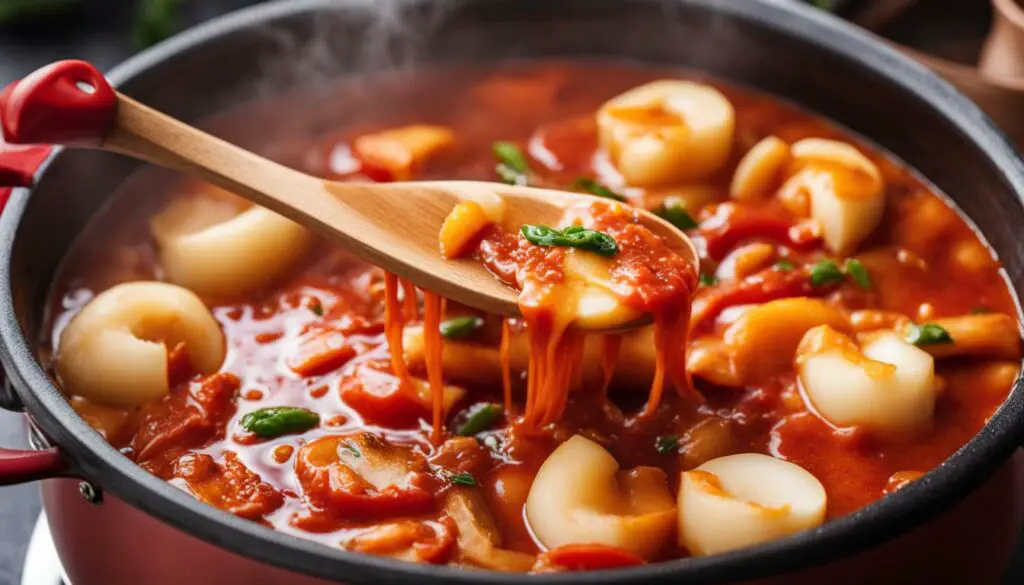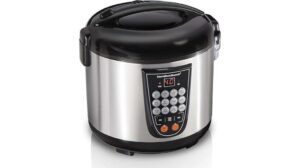Did you know that tteokbokki, a popular Korean street food dish made with chewy rice cakes, has its roots dating back to 1953? This beloved comfort food has become a staple in Korean cuisine and has gained international recognition for its unique flavors and textures.
Whether you’re a fan of Korean cuisine or simply curious about trying new flavors, learning how to cook Korean rice cake at home is a must-try experience. With the right ingredients and a few simple steps, you can recreate this delicious dish in your kitchen and impress your friends and family.
Table of Contents
Key Takeaways:
- tteokbokki is a popular Korean street food dish made with chewy rice cakes
- the dish originated in 1953 and has become a beloved comfort food
- the main ingredient is garaetteok, a cylinder-shaped rice cake made with short grain rice
- other ingredients commonly used include fish cake, cabbage, scallions, and garlic
- the sauce for tteokbokki is typically made with gochujang, a Korean red chili paste, along with other seasonings
What is Tteokbokki?
Tteokbokki, also known as ddukbokki or topokki, is a popular Korean rice cake dish. The name translates to “stir-fried rice cake” and it is often enjoyed as a street food. Tteokbokki has a rich history and was developed in 1953 by a woman named Ma Bok-rim in Seoul. The dish gained popularity as an affordable comfort snack after the Korean War. Traditional tteokbokki consists of chewy rice cakes in a spicy gochujang sauce, but variations with different ingredients and flavors have also emerged over time.
Tteokbokki is a staple in Korean cuisine and is beloved for its delightful combination of textures and flavors. The chewy rice cakes provide a satisfying bite, while the spicy gochujang sauce adds a fiery kick to the dish. Tteokbokki can be found in street food stalls throughout Korea, where it is cooked in large simmering pots and served piping hot.
“Tteokbokki is the epitome of Korean street food. The addictive combination of chewy rice cakes and spicy sauce makes it an irresistible treat.” – Kim Ji-yeon, Food critic
Over the years, tteokbokki has become incredibly versatile, with various regional and modern adaptations. Some popular variations include adding cheese for a creamy twist, incorporating seafood for a flavorful seafood tteokbokki, or even creating sweet versions by substituting the spicy sauce with a soy-based sauce. These variations have allowed tteokbokki to evolve and appeal to different tastes.
Tteokbokki holds a special place in Korean culture and is a dish that brings people together. Whether enjoyed as a quick snack on the streets of Seoul or cooked at home as a comforting meal, tteokbokki continues to captivate food enthusiasts around the world with its unique combination of chewy rice cakes and tantalizing flavors.
Ingredients for Tteokbokki
Tteokbokki, a classic Korean dish, is made with a few key ingredients that contribute to its delicious flavor and unique texture. Here are the essential components that make up this beloved dish:
| Ingredients | Description |
|---|---|
| Garaetteok | A type of rice cake made with short grain rice. It can be found fresh, refrigerated, or frozen at Korean markets. Garaetteok is the main component of tteokbokki, providing its chewy texture. |
| Fish Cake | A popular addition to tteokbokki, fish cake adds richness and depth of flavor to the dish. It can be sliced into thin strips or shaped into balls. |
| Cabbage | Adding some fresh cabbage to tteokbokki brings a crisp and crunchy element to the dish. It also balances out the spiciness of the sauce. |
| Scallions | Scallions, or green onions, provide a burst of freshness and a mild onion flavor to tteokbokki. They can be chopped and added as a garnish. |
| Garlic | Aromatic and flavorful, garlic enhances the overall taste of tteokbokki. It can be minced or thinly sliced for easy incorporation. |
The sauce for tteokbokki is what gives the dish its signature taste. Here’s a breakdown of the sauce ingredients:
| Sauce Ingredients | Description |
|---|---|
| Gochujang | A Korean red chili paste that forms the base of the tteokbokki sauce. Gochujang adds heat, depth, and a slightly sweet and savory flavor. |
| Gochugaru | Korean red chili pepper flakes that contribute to the spiciness of tteokbokki. Gochugaru also adds a vibrant red color to the sauce. |
| Sugar | A touch of sweetness balances out the spiciness of the sauce and enhances the overall flavor profile of tteokbokki. |
| Soy Sauce | A savory umami flavor is achieved by adding soy sauce to the tteokbokki sauce. It enhances the taste of the other ingredients. |
| Syrup | Syrup, such as corn syrup or rice syrup, can be added to the tteokbokki sauce to give it a glossy finish and a touch of sweetness. |
| Broth | The sauce is typically made with anchovy broth, which adds depth of flavor. However, water or vegetable broth can be used as alternatives. |
Feel free to adjust the quantities of gochujang and gochugaru based on your spice preference. Adding more will make it spicier, while reducing the amount will yield a milder sauce.
With these key ingredients and a flavorful sauce, you’ll be able to recreate the irresistible taste of tteokbokki right in your own kitchen.
How to Make Tteokbokki
To make delicious homemade tteokbokki, follow these simple steps:
- Start by soaking the rice cakes in water for about 20 minutes or longer. This helps soften the rice cakes and allows them to cook evenly.
- Cut the fish cake, cabbage, and scallions into bite-sized pieces.
- In a large pan, combine the sauce ingredients, including gochujang, gochugaru, sugar, soy sauce, and anchovy broth or water. Bring the mixture to a boil.
- Add the soaked rice cakes to the boiling sauce and cook them until they become soft and chewy. Stir occasionally to prevent sticking.
- Once the rice cakes are cooked, add the vegetables and fish cakes to the pan. Continue to simmer for a few more minutes until the vegetables are tender.
- Adjust the seasoning according to your taste by adding more gochujang or gochugaru if desired.
The cooking time may vary depending on the rice cakes, so ensure they are soft and the sauce has thickened before serving. You can also add more broth or water if needed to adjust the consistency of the dish.
For a vegan version of tteokbokki, simply use water or vegetable broth instead of anchovy broth and omit the fish cake. This way, you can enjoy the delicious flavors of tteokbokki while adhering to your dietary preferences.
Now that you know how to make tteokbokki, you can enjoy this popular Korean dish right in the comfort of your own home. Explore different variations and ingredients to create your own unique twist on this classic street food. Happy cooking!
How to Make Garaetteok
Garaetteok is a type of Korean rice cake that is commonly used in dishes like tteokbokki and tteokguk. It is made from non-glutinous rice flour and has a chewy and bouncy texture that adds a delightful mouthfeel to various dishes.
To make garaetteok at home, follow these simple steps:
- Soak and grind the rice: Start by soaking short grain rice in water for a few hours or overnight. Drain the soaked rice and grind it in a blender or food processor until it becomes a fine powder.
- Sift the rice flour: Sift the ground rice flour to remove any clumps or unground rice grains. This step ensures a smooth and uniform texture in the final rice cakes.
- Prepare the rice cake dough: In a mixing bowl, combine the sifted rice flour, cornstarch, and a pinch of salt. Gradually add boiling water to the dry ingredients, mixing continuously until a sticky dough forms.
- Knead and pound the dough: Transfer the dough onto a clean surface dusted with rice flour. Knead the dough for a few minutes, folding and pressing it with your hands to develop its elasticity. Then, use a pestle or a rolling pin to pound the dough gently, helping it become more pliable.
- Shape and cut the rice cakes: Divide the dough into small portions and roll each portion into a long cylinder shape. Cut the cylinders into bite-sized pieces. Optionally, you can also roll each piece on a cutting board to create a ridged texture that enhances the sauce’s clingability in dishes like tteokbokki.
Now your homemade garaetteok is ready to be used in various Korean recipes! Enjoy the chewy delight of these rice cakes in classic dishes like tteokbokki or explore other traditional preparations like tteokguk.
| Ingredients | Instructions |
|---|---|
| Short grain rice | Soak the rice in water for a few hours or overnight. Drain and grind it into a fine powder. |
| Cornstarch | Combine the sifted rice flour, cornstarch, and a pinch of salt in a mixing bowl. |
| Salt | Add a pinch of salt to the dry ingredients. |
| Boiling water | Gradually add boiling water to the dry ingredients, mixing continuously to form a sticky dough. |
| Knead the dough, then pound it gently with a pestle or rolling pin to improve its elasticity. | |
| Divide the dough into small portions, shape them into cylinders, and cut into bite-sized pieces. |
Tteokbokki Variations
Tteokbokki, the beloved Korean rice cake dish, offers a multitude of flavorful variations that cater to different preferences. From mild to spicy, vegetarian to seafood-filled, here are some popular tteokbokki variations:
Gungjung Tteokbokki
Gungjung tteokbokki is a non-spicy version that appeals to those who prefer milder flavors. It features rice cakes cooked in a soy-based sauce, along with a delightful medley of vegetables like carrots, mushrooms, and bell peppers.
Seafood Cheese Tteokbokki
For seafood lovers and cheese enthusiasts, seafood cheese tteokbokki is a must-try. This variation combines the rich umami of seafood, such as shrimp, squid, and mussels, with the creamy goodness of melted cheese, creating a heavenly fusion of flavors.
Soupy Tteokbokki
If you’re looking for a heartier and more comforting option, soupy tteokbokki is the way to go. This variation involves adding ramen noodles to the dish, resulting in a satisfying, brothy texture that will warm your soul.
These are just a few examples of the diverse tteokbokki variations you can explore to tantalize your taste buds. Feel free to get creative and experiment with additional ingredients and seasonings to customize your tteokbokki experience.
“Tteokbokki variations offer a delightful range of flavors and textures to suit every palate.” – Jane Kim, Food Blogger
See the table below for a quick reference to the key features of each tteokbokki variation:
| Tteokbokki Variation | Description |
|---|---|
| Gungjung Tteokbokki | A non-spicy version with a soy-based sauce and an array of vegetables. |
| Seafood Cheese Tteokbokki | Includes seafood like shrimp, squid, and mussels, along with delectable melted cheese. |
| Soupy Tteokbokki | Enhanced with ramen noodles, resulting in a comforting and brothy texture. |
Now that you know about these exciting tteokbokki variations, you can embark on a flavorful journey and discover your favorite twist on this beloved Korean dish!
Tips and FAQs
Here are some helpful tips and frequently asked questions about making delicious tteokbokki at home:
Tteokbokki Tips
- Soak the rice cakes: Before cooking, soak the rice cakes in water for about 20 minutes or longer to ensure they soften properly.
- Use fresh rice cakes: For the best taste, opt for locally made fresh rice cakes instead of frozen or refrigerated ones.
- Adjust the sauce: Customize the flavor of your tteokbokki by adding more or less gochujang (Korean red chili paste) and gochugaru (Korean red chili pepper flakes) to the sauce based on your personal preference.
Frequently Asked Questions about Tteokbokki
- How long should rice cakes be soaked? It’s recommended to soak the rice cakes for at least 20 minutes, but if they are dry, you can soak them longer to ensure they soften properly.
- What other broths can be used instead of anchovy broth? If you prefer a vegetarian or vegan option, you can use water or vegetable broth as alternatives to anchovy broth for the tteokbokki sauce.
- How can I make tteokbokki less spicy? If you prefer a milder flavor, reduce the amount of gochujang and omit gochugaru from the sauce. You can also add more sugar to balance the spiciness.
- How do I reheat leftover tteokbokki? To reheat leftover tteokbokki, heat it in a saucepan with some water or broth to maintain its moisture and prevent it from drying out.
With these tips and answers to common questions, you’ll be able to make mouthwatering tteokbokki at home with confidence.

Conclusion
Tteokbokki, a popular Korean rice cake dish, can be easily made at home with just a few simple ingredients and steps. The star of this dish is garaetteok, a type of chewy rice cake made with short grain rice. Along with the rice cakes, tteokbokki is traditionally made with fish cake, cabbage, scallions, and garlic, creating a flavorful combination.
The sauce for tteokbokki is what gives it its signature taste. Made with gochujang, a Korean red chili paste, along with gochugaru (Korean red chili pepper flakes), sugar, and soy sauce, the sauce adds a spicy and savory kick to the dish. However, tteokbokki is highly adaptable, allowing for variations and customizations. You can add ingredients like ramen noodles, dumplings, boiled eggs, hot dogs, seafood, or even cheese to create different flavors and textures.
With the tips and recipes provided, making homemade tteokbokki is a rewarding and enjoyable experience. Soak the rice cakes, follow the steps, and adjust the sauce to your taste preferences. Whether you prefer the classic spicy tteokbokki or want to explore different variations, now you have the knowledge and confidence to create your own delicious homemade tteokbokki that will surely satisfy your cravings.
FAQ
How long should rice cakes be soaked before cooking?
Rice cakes should be soaked for about 20 minutes or longer to ensure they soften properly.
What other broths can be used instead of anchovy broth?
Water or vegetable broth can be used as alternatives to anchovy broth for a vegan or vegetarian version of tteokbokki.
How can I make tteokbokki less spicy?
To make tteokbokki less spicy, reduce the amount of gochujang and omit gochugaru for a milder flavor.
How can I reheat leftover tteokbokki?
To reheat leftover tteokbokki, place it in a saucepan with some water or broth and heat it until warmed through.





